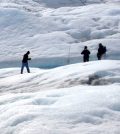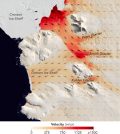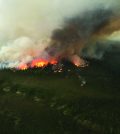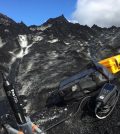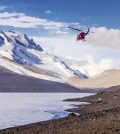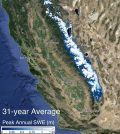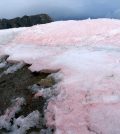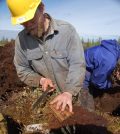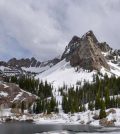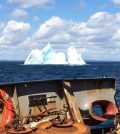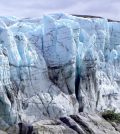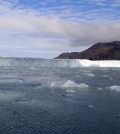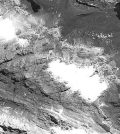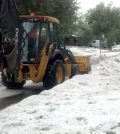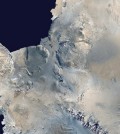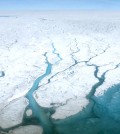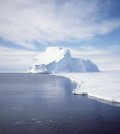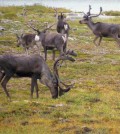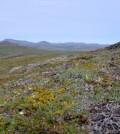Posts for tag "snow & ice"
Researchers Track Glacial Meltwater On Its Surprising Journey
Researchers stationed in Greenland tracked the fate of glacial meltwater as it wormed its way around the island nation to determine effects on productivity.
- Posted January 25, 2017
West Antarctica Glaciers Melt At Pace Not Seen Before
Researchers with the University of California, Irvine, and NASA have completed a pair of studies documenting the pace of glacier melt in West Antarctica.
- Posted October 27, 2016
Burning Permafrost: Handheld Water Quality Meters Track Impacts
Peristaltic pumps and handheld water quality meters aid Woods Hole Research Center scientists studying impacts of fire to Yukon River Delta permafrost.
- Posted September 8, 2016
Icelandic Glaciers: Western Kentucky University Scientists Sample In The Ice
Scientists at Western Kentucky University lead an investigation of Icelandic glaciers, dynamic ice sheets that are largely understudied.
- Posted August 22, 2016
Antarctic Lakes Hold On To Dissolved Black Carbon
In the McMurdo Dry Valleys, closed-basin Antarctic lakes retain dissolved black carbon from ancient wildfires and contemporary fossil fuel burning.
- Posted July 11, 2016
Sierra Nevada Snowpack Predicted To Recover From Drought By 2019
Recent years of drought have been tough for Sierra Nevada snowpack, which is still recovering from deficits. According to researchers at the University of California, Los Angeles, it will be another three years before the mountains get...
- Posted July 11, 2016
Red Snow Algae Worsening Arctic Melt
In a pioneering study, researchers have looked at the large-scale effects of red snow algae on Arctic ice and snow melt. According to a recent release from Helmholtz Centre Potsdam, the red algal blooms that occur seasonally...
- Posted July 8, 2016
Dry, Wet Thawing Permafrost Soils Affect Greenhouse Gas Ratios
Numerous studies into thawing permafrost soils reveal insights into carbon dioxide and methane ratios impacting the permafrost carbon feedback loop.
- Posted June 29, 2016
Precipitation Most Important For Western Snowpack, To A Point
Scientists at the University of Utah have further pinpointed the dynamics at play in the buildup of snowpack, according to a release. Their research focused on Utah’s Wasatch Mountains as well as other ranges in the West....
- Posted June 29, 2016
Tracking Elephant Seals Reveals Antarctic Melt Insights
Elephant seals are helping scientists get to the bottom of Antarctic ice melt, according to the Washington Post. Antarctic ice sheets are melting from the bottom up instead of from top to bottom. The reason for this...
- Posted June 22, 2016
Fate Of Greenland Meltwater Affected By Winds, Currents
In recent decades, researchers have watched as land ice on the island of Greenland has melted, spurring questions about the impacts to sea levels. But what has not been questioned as much is the fate of all...
- Posted June 13, 2016
Seismic Waves Track Greenland’s Ice Melt
MIT researchers have found a new way to monitor changes in Greenland’s ice sheet: seismic waves. The waves occur as the ocean crashes against the ice sheet, creating vibrations that can be detected and measured with high...
- Posted May 25, 2016
Revised Maps Of Seafloor Around Greenland Mean Greater Melting Risk
Thanks to new maps of the seafloor around Greenland’s glaciers, scientists at the University of California, Irvine, believe that the glaciers may be more prone to melting from below than once thought. That’s because the depths beneath...
- Posted May 25, 2016
New Guinea Glaciers Decimated Due To Climate Change
A University of Plymouth study using high-resolution satellite images has shown that once sizeable tropical glaciers in New Guinea have nearly disappeared in the past 15 years, largely due to climate change effects and unprecedented temperature rise....
- Posted May 2, 2016
Citizen Scientists Can Help Deep Hail Project
If you live in Colorado and use Twitter, Facebook or even plain email, researchers at the University of Colorado at Boulder would like your help with the Deep Hail Project. The effort is looking to gauge the...
- Posted April 29, 2016
Antarctic Ice Sheets Weakened By ‘Upside-Down Rivers’
Antarctic ice sheets are very vulnerable to climate change, scientists say, because they feel its impacts from above and below. Warmer air temperatures come down at them, while warmed ocean waters are creating areas of heated ocean...
- Posted April 12, 2016
Rising Sea Levels Linked With Greenland Changes
Scientists at Rutgers University have found that rising sea levels are linked with a number of trends around Greenland. These include vanishing Arctic sea ice, persistent weather systems and surface ice melting on the island itself. During...
- Posted April 8, 2016
Antarctic Ice Sheet Melt Could Cause Catastrophic Sea Rises
Already melting in response to global warming, the Antarctic ice sheet may collapse if greenhouse gases aren’t curbed, scientists warn in a release from Victoria University of Wellington. If the ice sheet collapses, the sea level could...
- Posted March 31, 2016
More Snow May Increase Alaskan Tundra Permafrost Degradation
An increase in snowfall is likely to lead to more Alaskan tundra permafrost degradation and changes in methane and CO2 production and absorption.
- Posted March 22, 2016
Alaskan Tundra Active Layer In Danger Of Microbial Degradation
Permafrost health and its eventual degradation is a persistent concern for many scientists. Permafrost can be defined as soil deep below the surface that remains frozen for at least two years. In contrast, the active layer is...
- Posted March 21, 2016


